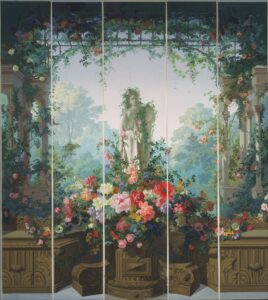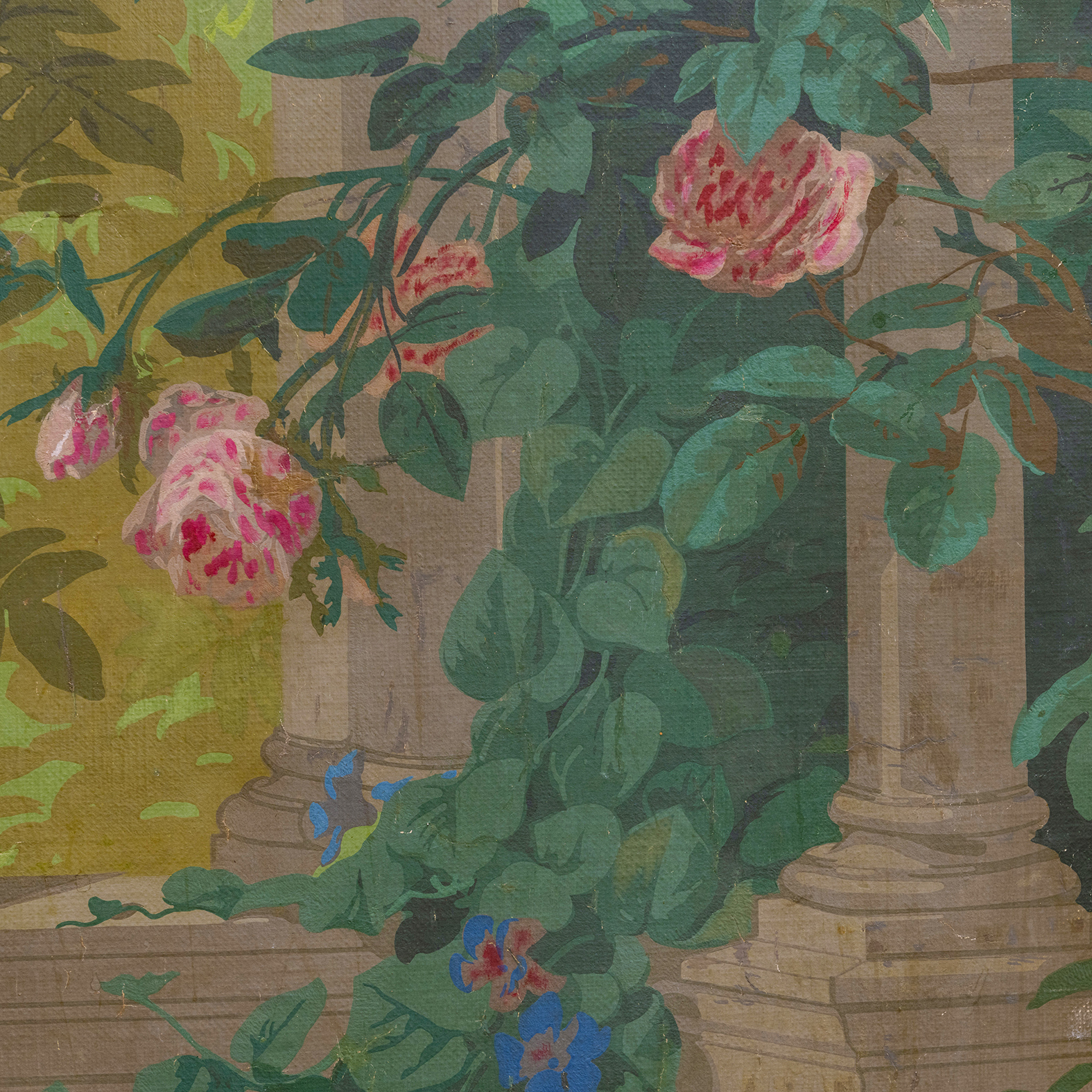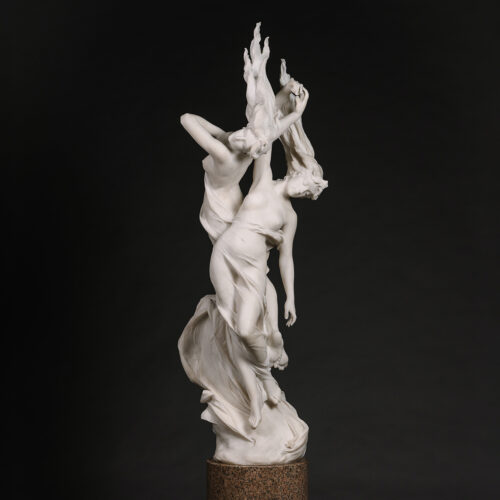Manufacture Jules Desfossé
‘Le Jardin d’Armide’ (‘The Garden of Armida’) A Rare Wallpaper Panel Designed By Édouard Muller
£28,000
'Le Jardin d'Armide' (‘The Garden of Armida’) A Rare Wallpaper Panel Designed By Édouard Muller (1823 - 1876) and Manufactured By Jules Desfossé. Woodblock...
Размеры
Height: 276 cm (109 in)Width: 332 cm (131 in)
Описание
‘Le Jardin d’Armide’ (‘The Garden of Armida’)
A Rare Wallpaper Panel Designed By Édouard Muller (1823 – 1876) and Manufactured By Jules Desfossé.
Woodblock hand printed and polychrome painted paper panel of five strips mounted on canvas (restorations; hand painting concealing paper joins; over-painting; traces of old varnish).
France, Circa 1854-70.
The wallpaper manufacturer Jules Desfossé expressly sought to elevate his craft by associating his industrial productions with illustrious names from the fine arts. His best known collaboration was with the French painter and designer Édouard Muller (1823-1876) whose most famous creation for Desfossé is ‘The Garden of Armida’ (1854). It was presented at the Paris Universal Exhibition in 1855 and stimulated new trends in the art of panoramas.

The three panels and frieze of putti of the ‘The Garden of Armida’ as shown at the Paris Universal Exhibition in 1855 (Courtesy of Desfossé et Karth, reproduced in Nancy McClelland, Historic wall-papers, Philadelphia, 1924. p. 331).
Muller conceived of ‘The Garden of Armida’ as three tableaux framed by a border and surmounted by a frieze of putti. The central panel of the triptych has a statue of Flora and the flanking panels have flower filled basins hung from chains.

A suite of three panels with centre panel with figure of Flora and flanking panels with basins of flowers (Private Collection).
Examples of the central scene, with statues of Flora, are in the The Musée d’Orsay (Inventory Number NV 22632 2) and Philadelphia Museum of Art (Accession Number: 1988-57-1a—e). The Cooper Hewitt, Smithsonian Design Museum, holds in its collection one flanking panel of a flower filled basin (1953-158-4) and a dado paper fragment (1955-12-5-a/c). ‘The Garden of Armida’ was produced in quantity, although surviving examples are rare and vary in date. A set in Musée des Arts Décoratifs was a gift of the manufacturer in 1882 (MAD inv.22632, 29810 et 52443). The central panel in the Philadelphia Museum of Art has a more recent feel, and may very well be traceable to A. L. Diament & Co. who were based in Philadelphia as sole American Agents for Desfosse & Karth and list ‘The Armida Gardens’ as being ‘now reprinted from the original hand blocks’ in their portfolio of circa 1910.

‘The Garden of Armida’ wallpaper centre panel with figure of Flora, measuring 386 × 335 cm. (Philiadephia Museum of Art, Accession Number: 1988-57-1a—e)
The present scene is a variation without the statue of Flora and with subtle differences to the design of the architectural balustrade which, in the versions with Flora, has a central socle supporting the statue. These variations indicate that the present panel was likely made as part of a larger set decorating a room from which the statue of Flora was omitted for compositional purposes. The mounting on canvas and the extensive pinholes to the outer edge suggest it was hung within a boiserie panel.
‘The Garden of Armida’ title is derived from a location in the 16th-century Italian epic poem ‘Jerusalem Delivered’ by Torquato Tasso. Many painters and composers were inspired by Tasso’s tale which recounts the mythic exploits of the knight Rinaldo in the First Crusade. Rinaldo falls under the spell of a sorceress named Armida in garden of otherworldly paradise. Édouard Muller arranges the garden as a theatrical trompe l’oeil, the exuberant flowers, colonnades and trellises capture the conservatories, winter gardens and verandas so fashionable in Second Empire Paris. Upon its unveiling at the 1855 Paris Exhibition, ‘The Garden of Armida’ earned Jules Desfossé a first glass medal.
Дата
Circa 1854-70
Происхождение
Франция
Средний
Woodblock hand printed & painted
Jules Desfossé (d. 1889) is recorded in 1851 to have purchased the stock printing plates and decorations of the Mader wallpaper manufacturer. In 1863 Desfossé became a partner of his bother-in-law Hippolyte Karth, who was himself successor of the Dauptain, Brière, Clerc and Margeridon factories. In 1865 by buying the firm of Kob et Pick, Desfossé inherited the prestigious stock of Dufour, who had been famed in the early 19th century for producing panoramic décors.
In addition to reprinting the celebrated designs of his predecessors, Desfossé was especially keen to create new designs which elevated wallpaper to the realm of fine art by working with established artists to create new designs.
Between 1862 and 1861 Desfossé created panoramic decorations which appealed greatly to the luxuriant tastes of the Second Empire and won him universal admiration, especially through his collaboration with Édouard Muller (1823 – 1876) who designed the panoramic wallpapers of ‘The Winter Garden’ (1853), The Garden of Armida (1854) and ‘The Gallery of Flora’ (1857). Muller had a distinct and exceptionally adept style of rendering flowers naturalistically and was extremely knowledgeable about printing techniques and trompe l’oeil. His densely back floral designs for Desfossé were handprinted by wood block and used as many as 380 different colours.
Desfossé exhibited and was awarded at all the Great Exhibitions of the nineteenth century including Paris in 1855 and 1867 and London in 1862. Wallpaper by Jules Desfossé is preserved in international museum collections including Musée des Arts Décoratifs, Paris, The Philadelphia Museum of Art and the V& A, London.
‘The Second Empire 1852-1870, Art in France under Napoleon III’, Exhibition Catalogue, Philadephia Musuem of Art/Detroit Institute of Arts/ Grand Palais, Paris, 1978. No. II-16, pp. 92-93 and cover illustration.















 Печать
Печать


